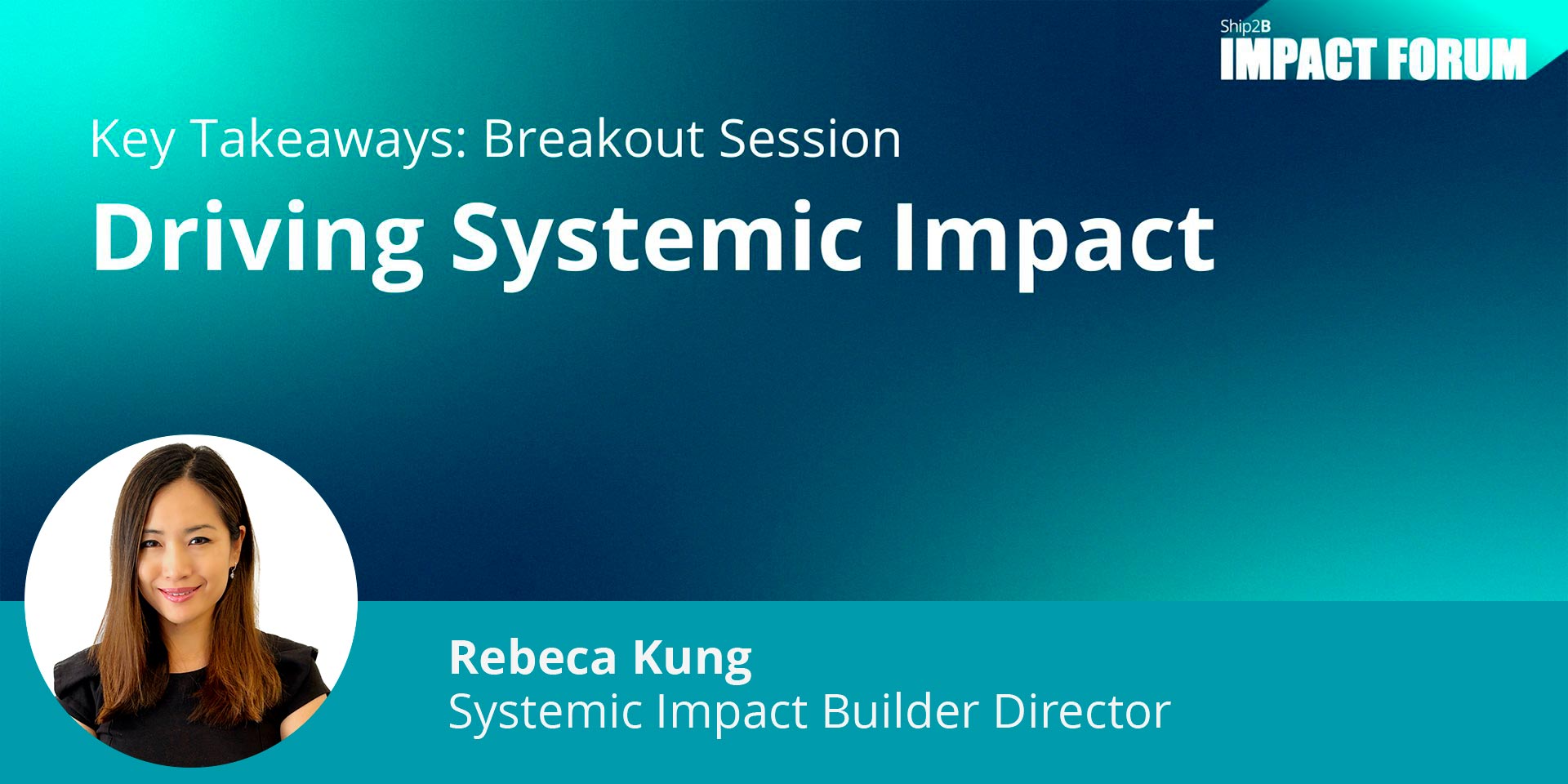
I. Introduction
This meeting brought together diverse stakeholders, ranging from public institutions, impact funds, foundations, family offices, academia to systems thinkers and practitioners from 10 countries, to explore the synergy between impact investing and systems change, with a goal of enabling transformative, scalable impact. While impact investing has seen significant growth, questions remain regarding the breadth and depth of impact achievable within current frameworks. The convergence of systems change approaches with systemic investing presents an opportunity to tackle these challenges by addressing root causes, aligning diverse stakeholders, and fostering innovative approaches to financing.
II. Challenges with Current Impact Investing Approaches
Impact investing has grown considerably, but its potential remains limited by several key challenges:
- Focus on Incremental Changes over Root Causes
While many impact investments yield measurable benefits, they often focus on optimizing existing systems rather than addressing underlying systemic issues. This approach can perpetuate the status quo and fails to tackle the underlying factors that make social and environmental issues persist. Impact effort can address problems at three levels, which reflect increasing engagement and influence on the systems: system optimization, partial system redesign, and full systems change. Most impact initiatives focus primarily on system optimization.
2. Misaligned Timelines and Metrics
The timeline for systems change is often incompatible with traditional investment horizons. Impact investments must be evaluated over extended periods to capture their full effects, but short-term financial metrics do not always reflect this need. The way impact is currently measured often focuses on short-term individual outputs or outcomes (e.g. increase skills) vs long-term systemic changes (e.g. are people learning the right skills for the change to happen). In addition, extractive investments generate externalities that are not currently factored into financial performance metrics, which places impact investing at a disadvantage and hinders a wider adoption of the impact paradigm.
3. Lack of Coordination among Investors and with Other Stakeholders
With investors often operating in silos, opportunities for collective action and magnified impact are missed. Increased collaboration and coordination are essential to unify efforts and avoid duplicating initiatives. System-level transformation requires building a complex network involving different stakeholders from private, public and social sectors. Investors or change makers working at the sectoral level may not be able to detect possibilities outside of their fields. An example of this is leveraging tax measures to drive climate initiatives that deliver substantial results, a strategy that necessitates active collaboration with policymakers.
4. Funder Readiness
Most funders, including investors, public institutions and philanthropists have yet to fully embrace the systemic approach due to the lack of familiarity with its demands, methodologies, and long-term objectives. While increasing numbers of investors expressed their interest, barriers such as the entrenched dominance of traditional paradigms, the absence of robust frameworks, and incentive structures that prioritize short-term returns over enduring impact are preventing a wider acceptance of the systems change approach. Many social investors continue to prioritize their own definition and mission rather than responding to field decision makers.
III. How to Advance Systemic and Transformative Impact
- Balance Top-Down and Bottom-Up Approaches
Effective systemic impact practice requires a nuanced approach that combines top-down strategic planning with adaptive, bottom-up insights. Systems change cannot be orchestrated solely from above. It is about giving the communities you seek to serve much more agency and voice, for instance in defining goals and in measuring them, as local niches and grassroots actors play a crucial role in identifying and responding to emergent issues. Scaling systemic solutions also involves addressing tensions between localized, context-specific approaches and the desire for wide-reaching impact.
Achieving systemic and transformative impact requires a mindset shift at all levels—personal, collective, and cultural—emphasizing shared power and decision-making. Instead of concentrating control in investors, power must be redistributed among stakeholders, aligning with community-driven goals, and considering input from diverse actors such as civil society and government.
2. Combine Solution Replication and Adaptation
While replicating proven models can extend their benefits, careful adaptation to local contexts is often necessary for true systemic impact. Effective scaling strategies incorporate both replication and local customization, respecting unique community needs and conditions. Incorporating flexibility into the design and implementation phases allows solutions to be tailored in ways that respect the local context. This dual approach not only preserves the core principles of the original model but also fosters deeper engagement and ownership within the community, ultimately leading to more sustainable and transformative outcomes.
3. Empower Stakeholder Orchestration
Systems change is inherently complex and demands multi-stakeholder collaboration; no single entity can achieve widespread transformation alone. Institutional innovations are therefore required for ecosystem building, leading to the creation of a new type of intermediary—an orchestrator. The role of the orchestrator is key to aligning stakeholders, fostering relational shifts, anchoring partnerships and ensuring capital is directed effectively toward systems change. However, effective orchestration is a delicate balance, as power and decision-making must be shared and governance structures need to evolve over time to remain inclusive and responsive.
Orchestration may have a different focus at different levels and stages of systems change. In local contexts, it would require ecosystem builders and facilitators to foster collaborative networks; one example is to put forward a shared agenda that has a participative governance and a coordination office providing a common narrative, a theory of change, indicators, coordinating actors and quantifying the necessary investments. For scaling, large-scale systems players should be involved to support impactful initiatives that have achieved successful outcomes locally, while adapting and evolving the orchestration mechanism.
Who should play the role of the orchestrator remains undefined, and may vary depending on the context, the nature of collaboration and the specific needs of the project. Supporting orchestration activities demands resources that are often challenging to secure. Yet, without this investment in coordination, systems change initiatives are unlikely to achieve their potential.
4. Rethink Finance as a Tool and Explore the Full Range of Instruments
Financial resources should support, rather than dictate, the agenda for systems change. Systemic impact requires patient, catalytic capital and blended financing that combine public, private, and philanthropic funding. This inclusive approach allows investors and funders of different objectives and risk profiles to join forces and support transformative initiatives, prioritizing long-term outcomes over short-term returns. There is also a need for financial instruments that not only focus on individual projects but also consider their relationships and contributions to broader systemic transformative processes. On the other hand, investors shall not lose sight of the opportunities offered by exploring the full range of existing financial instruments, new and old (bonds, futures, etc) and evaluate the viability and potential of their application to systems change initiatives. It is also important to note that there would be times where “finance” is not the answer.
5. Reevaluate and innovate Impact Metrics
Traditional financial metrics often fail to capture the complexities of systemic change. Thus, new frameworks and metrics are needed to reflect the true impact and the sustainability of investments. The development of these tools is crucial for aligning impact funding and investing with the timelines and requirements of systems change. Moreover, new frameworks must reconsider who defines success and how it is measured, emphasizing the importance of the role of the communities.
IV. Going Forward
Participants agree that following actions are necessary to drive systemic impact:
● Build Evidence by Expanding Case Studies
To advance understanding and adoption of systemic investing and systems change approaches, it is essential to document and share successful examples. Expanding the repository of case studies will provide a practical framework for guiding future efforts and serve as compelling evidence of the viability and effectiveness of these methods. These documented cases can highlight best practices, key challenges, and critical success factors, offering valuable insights to investors, practitioners, and stakeholders. By showcasing diverse contexts and innovative strategies, the case studies will not only build credibility, but also inspire confidence and enable broader engagement in scaling systems change initiatives.
● Foster System-Level Research and Knowledge Sharing
Ongoing research is crucial to advance innovative financial instruments and metrics that align with systems change goals. Practitioners welcome the creation and knowledge building related to new funding models, such as blended finance or outcome-based contracts that address the unique complexities and long time horizons. Furthermore, there is a need to develop tools to measure systemic impact taking into account the complexity and time span of system-level efforts, enabling stakeholders to track progress, learn from setbacks, refine strategies, and drive meaningful change. In addition, Systems change requires interdisciplinary approaches; synthesizing, crossing and sharing evidence, insights and perspectives from diverse sectors may shed new light on the evolution of systems approach.
● Support Orchestration Efforts and Pilots
As stakeholder coordination is pivotal, the development of orchestration mechanisms and funding to support orchestration roles shall be prioritized to enhance impact potential. Participants also agree that it is important to support pilot launch to test and refine systemic impact theories and strategies, transforming visionary concepts into actionable realities that embed systems approach into the core of intervention design and implementation.
Systems change requires bold experimentation, yet entrepreneurs and change makers often face barriers such as short-termism, extractive cultures, single-product paradigm and insufficient resources, when taking risks to explore and scale transformative approaches. Investors and stakeholders shall provide support, resources and collaborative networks that enable the creation of complex, system-shifting solutions. Stakeholders, investors and innovators are also urged to consider and explore the potential of technological advancements, such as AI, in accelerating and scaling system-wide impact.
Content contributed by (in alphabetical order):
Alejandro Alvarez von Gustedt – VP Europe, Rockefeller Philanthropy Advisors
Ana Pimenta – Chief Impact Strategist, Blink c.v.
Antonio Gonzalez – CEO, Impact Hub Madrid
Blanca Hernández – Founder & President, Fundación TuTecho | Magallanes Value Investors
Braulio Pareja – Head of Academic Research, Impact Bridge
Clara Navarro – Independent advisor | Co-founder at Ship2B Foundation
Cristina San Salvador – General Director, Fundación JEA
Danyal Sattar – CEO, Big Issue Invest
Dirk Meuleman – CEO, Phenix Capital Group
Elena Casolari – Partner & CEO, Opes Italia
Federica Massa – Professor & CSO, EADA
Giorgiana Notarbartolo – Head of Impact & Philanthropy, PFC Family Office
Jason Jay – Director of Sustainability Initiative, MIT Sloan
Johan Schot – Director, Deep Transition Lab
Pascal Vinarnic – Founder, Fondation Demeter
Raúl Sánchez – Director of Impact Investment, COFIDES
Rebeca Kung – Director, Systemic Impact Builder at Ship2B
Suzanne Jenkins – Head of Impact & Systems Change, Impact Shaker
Tatiana Fernández – Head of Transformative Innovation, Generalitat de Catalunya
Teresa Guardans – Founding Partner, Oryx Impact
Tharald Nustad – Founder, Katapult Group | TWIST: Investing for Systems Change
Uli Grabenwarter – Director of Equity investments, European Investment Fund
Viliana Dzhartova – Co-Founder & Principal Consultant, Reimagined Future
Xavi Pont – President & Co-Founder, Ship2B Foundation

Rebeca Kung
Systemic Impact Builder Director
Strategist, entrepreneur, and linguist with a passion for innovation and interdisciplinary practice. Rebeca holds an MBA from IESE Business School and MACI from the Middlebury Institute of International studies at Monterey, California. In her past roles, she gained a wealth of experience working closely with leaders in the private and public sectors, including international organizations and MNEs at the highest levels in strategy, international relations and communication. As a management consultant at McKinsey, she specialized in transformation, due diligence and board strategy, advising sectors across Renewables, Advanced Industries, CPG, ICT and Port Operations. She is also X2 founder, of a conference multilingual comms business serving 26 countries, and a marketplace/ecommerce aimed at empowering emerging artists, helping them reach collectors in 10 countries, as well as a physical gallery dedicated to underrepresented, emerging contemporary African and female artists. Currently she leads the Systemic Impact Builder Initiative at Ship2B, an initiative aimed to converge systems thinking and systemic investing for lasting, scalable impact.
